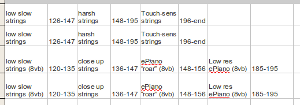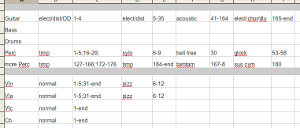A Music Director's Epic Tale: Les Miserables
Chapter 6 : Bringing The Music To Life
6.1 - Sorting Out The Instruments
The score for each instrument part for each song had to be studied to see what actual instruments were needed. For example, "Woodwind 1" actually plays clarinet, flute and alto sax (i.e., "instrument doubling").
This became especially important for the first two keyboard books. There are so many different keyboard sounds in this show! In my early research on the show I was able to get a list of the original Yamaha DX7 sounds used. The DX7 was a synthesizer that was sold by Yamaha in the mid 1980s. It used something called frequency modulation (FM) synthesis to create sounds.
I also found out that four DX7s were used by the keyboard players in the show. Because the DX7 only has 61 keys, but the range of pitches required in the show was greater than that, and also because the DX7 only has a memory bank of 32 patches, the person who did the original synth programming for the show (John Cameron, who was also the show's orchestrator) decided to have each keyboardist use two DX7s ("upper" and "lower", basically like the manuals on an organ). The tricky part is that in several sections of the show for a specific keyboardist, you could have one patch on the upper and a different one on the lower. I believe that when the show was performed, each keyboardist had a score page turner that also doubled as patch button pusher!
While I didn't use DX7s in our run of "Les Mis", as mentioned in the "gear" chapter (in 4.4 - Synthesizers), I made use of Native Instruments' FM8 soft synth, plus other patches in my other synthesizers, to get all the right sounding keyboard bits. Too often I've heard and seen stagings of "Les Mis" where the keyboardists just pick a few keyboard patches (electric pianos, etc.) that sound "good enough", as sort of an "average" of some of the many textures that were originally intended to be heard. Unfortunately, that's not good enough for my ears. John Cameron intended certain types of keyboard sounds to be mixed in with the more classical elements of the orchestration, and it is worth it to try to dig in and reproduce those sounds as closely as he originally intended.
To the other extreme, there are many musical directors of this show who spend a great deal more time than even I did in attempting to assemble and recreate the sounds for the show. To make matters even more difficult, the show is always evolving (even the original DX7s gave way to other synthesizers such as those made by Kurzweil) and there is a new version of the show (new orchestrations, new sounds) to be released in 2011 or 2012. It's a constantly moving target, and everyone's ears are different as we all try to make the show "sound the best".
One potential resource for MDs looking to have "all the sounds in one box" is to rent the sounds from Realtime Music Solutions. They have all the keyboard patches for this show (and others) in the order they are used in the show. There is debate amongst MDs about whether all the patches sound "good enough" but it's definitely a resource to consider.
Getting back to my own treatment of the sounds for the show, in yet another example of how important it is to stay organized, for each song, then, I developed a spreadsheet that listed the score book (Woodwind 1, Woodwind 2, etc.) on the left hand side and then had pairs of columns for measure range and actual instrument and/or articulation required.
The screenshots below show an example of this, taken from the worksheet I put together for "Building The Barricade".
Woodwind and brass section of orchestration worksheet for "Building The Barricade". Click on image to enlarge.
Keyboard section of orchestration worksheet for "Building The Barricade". The number of different types of keyboard patches is so large (typical for all songs in the show) that it takes two screenshots to show everything! Click on each image to enlarge.
Guitar, string and percussion section of orchestration worksheet for "Building The Barricade". Click on image to enlarge.






